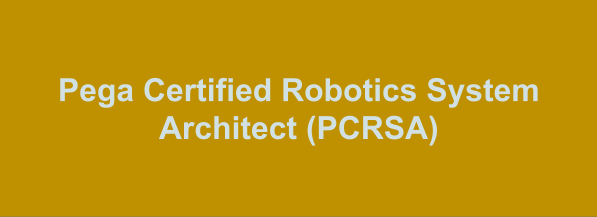The Pega Certified Robotics System Architect (PCRSA) certification is designed to validate the basic skills, knowledge, and tasks specific to automating Robotic solutions.
Pega Certified Robotics System Architect (PCRSA)
The PCRSA Version 8 exam includes scenario questions, multiple choice questions and drag/drop items. If multiple answers are required, the text states how many responses are needed.
Pega PCRSA Exam Summary:
| Exam Name | Pega Certified Robotics System Architect |
| Exam Code | PCRSA |
| Exam Fee | USD $175 |
| Exam Duration | 90 Minutes |
| Number of Questions | 60 |
| Passing Score | 65% |
| Format | Multiple Choice Questions |
| Books / Trainings | Class Schedule |
| Sample Questions | Pega PEGAPCRSA80V1_2019 Exam Sample Questions and Answers |
| Practice Exam | Pega Certified Robotics System Architect (PCRSA) Practice Test |
Pega Robotics System Architect Syllabus Topics:
| Topic | Details | Weights |
| Project Management | - Identify importance of Solution Design Documents - Identify importance of Solution Architecture Documents - Recognize solution structure based on project documentation - Define types of projects created for a robotic solution - Recognize proper naming conventions of solutions and projects |
5% |
| System Integration | - Recognize and configure Pega Robot Studio adapter types - Identify adapter properties and values of Windows adapters - Identify adapter properties and values for Web adapters - Identify adapter properties/values for Universal Web adapters - Modify the properties of an object |
8% |
| Interrogation | - Identify elements created and used during interrogation - Recognize the difference between Web and Windows interrogation - Interrogate Web applications - standard, Select Element methods - Identify the purpose of Global web pages during interrogation - Know why and when to use Select Element to interrogate - Describe the Create Control method of interrogating - Modify match rules for windows and web adapters - Modify Universal web adapter match rules - Identify match rule best practices and common issues - Identify working panes in the Adapter Match rules tab - Add and edit match rules for an interrogated control |
13% |
| Debugging and Diagnostics | - Evaluate data values in an automation during debugging - Update diagnostics settings - Add a diagnostic log component to an automation - Dissect a log file - Use the Automation playback feature - Clear a log file |
20% |
| Automations | - Describe relationship between Object Explorer and automations - Implement the Object Explorer in automation development - Create an automation - Implement Message dialogs - Identify types of automation links - Create an automation procedure using Label/Jump To Components - Application and setting of UseKeys property - Implement the RaiseEvent method within an automation - Identify uses and extraction of data proxies - Create a windows form for use in a project - Describe Toolbox components: Variables, Excel file connector - Identify Decision Blocks, Comparisons, and Expressions - Describe use of utilities for Strings, Dates, and Files - Describe use of Wait logic - Differentiate use and parameters for Automation looping - Describe and implement of Assisted Sign-On - Describe and implement Start My Day, Message Manifest |
33% |
| Interaction Framework | - Explain and modify the interaction.xml file - Configure and use the Interaction Manager component - Explain and create a project-to-project reference - Define the structure of context values - Implement an activity component |
13% |
| Deployment | - Create Project configuration files - Use of Project deployment properties - Create a deployment package |
8% |





0 comments:
Post a Comment